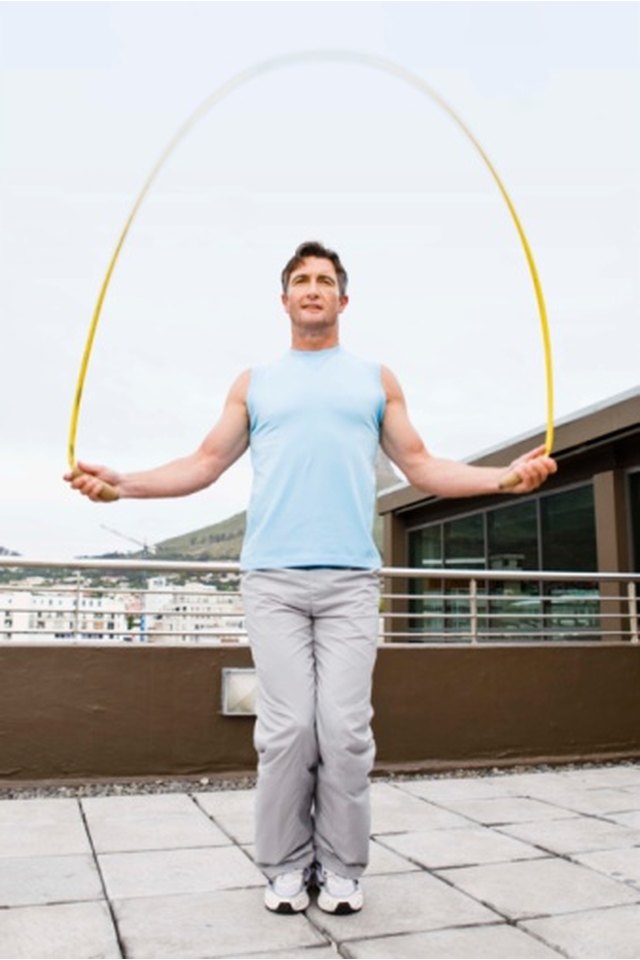What does fact checked mean?
At SportsRec, we strive to deliver objective content that is accurate and up-to-date. Our team periodically reviews articles in order to ensure content quality. The sources cited below consist of evidence from peer-reviewed journals, prominent medical organizations, academic associations, and government data.
The information contained on this site is for informational purposes only, and should not be used as a substitute for the advice of a professional health care provider. Please check with the appropriate physician regarding health questions and concerns. Although we strive to deliver accurate and up-to-date information, no guarantee to that effect is made.
Does Jumping Rope Build Fast-Twitch Muscle Fibers?

Jumping rope is one of the oldest and most widely available ways to exercise because it’s inexpensive and can be done just about anywhere. Best of all, jumping rope offers aerobic and anaerobic benefits to several muscles groups, including your leg and arm muscles. Building fast-twitch muscle fibers can help increase your speed and quickness.
Fast-Twitch Muscle Fibers
Fast-twitch muscle fibers are responsible for your speed and explosiveness, and genetics plays a major role in the amount of fast-twitch muscle fibers you have. That said, about 40 percent of your muscles can be influenced through exercise and training. Endurance exercises will build slow-to-intermediate twitch muscles while speed exercises like jumping rope will help build fast-twitch muscle fibers for increased speed and agility.
Muscles Worked
Skipping rope can be considered a compound exercise since multiple muscle groups are worked during each session. According to HumanKinetics.com, jumping rope works your quadriceps, hamstrings, glutes, calves, ankles and feet, shoulders, forearms, and wrist and hand muscles. Additionally, it helps improve your hand-eye coordination and stimulates production of fast-twitch muscle fibers within each of the aforementioned muscle groups.
Workout Regimen
The key to building fast-twitch muscle fibers by jumping rope is to use short, intense intervals of training -- similar to a high intensity interval training (HIIT) program. Start by skipping rope at a rapid pace for 30 to 60 seconds, rest for the same length of time and repeat this cycle five to 10 more times. Once you’ve completed as many as 10 rest-and-work cycles, rest for two to five minutes and repeat the workout. Maintain a high intensity during each work cycle to maximize your fast-twitch muscle production. Do this workout up to three times per week with at least a day of rest in between. For additional fast-twitch fiber building, do some of your intervals with high knees. Jump on alternating legs and lift your knees high, as if you were sprinting.
Benefits
Jumping rope offers many benefits when it comes to building speed and agility. It’s an inexpensive and effective compound exercise that doesn’t take too much time out of your day. There also are many variations of skipping rope you can use to help keep each workout fresh and promote “muscle confusion,” or keeping your muscles from getting used to your workout. HumanKinetics.com states that jumping rope is an exceptional exercise routine for rehabilitation after an injury because of its aerobic and strength-training benefits.
Explore In Depth
References
- ExRx.net: Muscle
- Human Kinetics: Benefits of Jumping Rope During Injury Rehabilitation
- High-Performance Sports Conditioning; Bill Foran
- Weight Training for Running -- The Ultimate Guide; Rob Price
- Trecroci A, Cavaggioni L, Caccia R, Alberti G. Jump Rope Training: Balance and Motor Coordination in Preadolescent Soccer Players. J Sports Sci Med. 2015;14(4):792-798.
- Baumgartner L, Weberruß H, Oberhoffer-fritz R, Schulz T. Vascular Structure and Function in Children and Adolescents: What Impact Do Physical Activity, Health-Related Physical Fitness, and Exercise Have? Front Pediatr. 2020;8:103. doi:10.3389/fped.2020.00103
- Ozer D, Duzgun I, Baltaci G, Karacan S, Colakoglu F. The effects of rope or weighted rope jump training on strength, coordination and proprioception in adolescent female volleyball players. J Sports Med Phys Fitness. 2011;51(2):211-219.
- Van Hooren B, Peake JM. Do We Need a Cool-Down After Exercise? A Narrative Review of the Psychophysiological Effects and the Effects on Performance, Injuries and the Long-Term Adaptive Response. Sports Med. 2018;48(7):1575-1595. doi:10.1007/s40279-018-0916-2
Writer Bio
Joseph Eitel has written for a variety of respected online publications since 2006 including the Developer Shed Network and Huddle.net. He has dedicated his life to researching and writing about diet, nutrition and exercise. Eitel's health blog, PromoteHealth.info, has become an authority in the healthy-living niche. He graduated with honors from Kellogg Community College in 2010 with an Associate of Applied Science.
